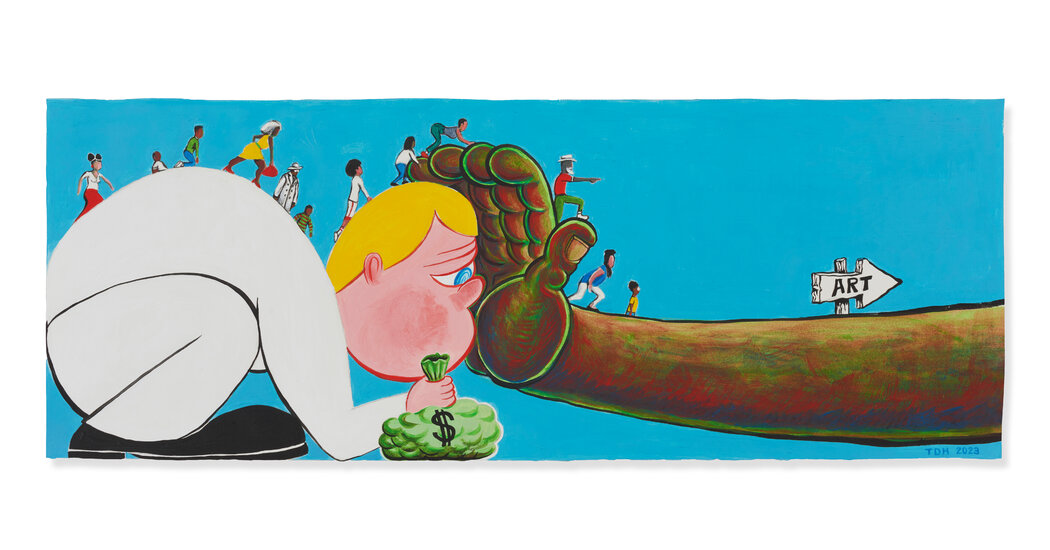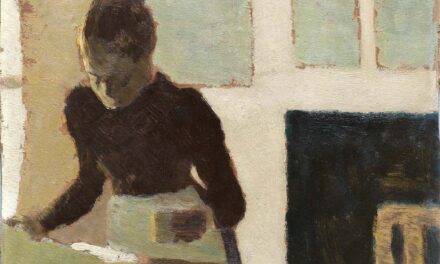
A younger, more diverse generation of artists are demanding a greater say in which collectors end up with their work.
IN JANUARY 2020, less than two months before galleries around the world closed to the public because of Covid-19, Lauren Halsey had a solo show at David Kordansky Gallery in Los Angeles. She was exhibiting works about the historically Black community in South Central — where she was born, raised and still works — which is physically quite close to the gallery in Mid-Wilshire but is spiritually farther away. A big crowd came to the opening to see Halsey’s large-scale sculptural installations, which resembled storefront signage, some featuring protest slogans. “Reparations Now! In Memory of Our Black Ancestors,” one of them read. “Black Workers Rising! For Jobs Justice & Dignity,” said another.
But the show soon caught the art world’s attention for a different reason after a white collector posted on Twitter what he claimed to be a note attached to a sales list from the gallery, which indicated that a number of Halsey’s works were not for sale. Or at least not for sale to him. According to the gallery, in a statement released to Artnet at the time, “Per the artist’s wishes, we reserved certain (not all) sculptures from this body of work for people of color and public collections.” Halsey, 36, wanted her art to be acquired — to be lived with — by a diverse group of owners who’d have a special appreciation for the artist’s overall project, which is dedicated, as she’s put it, to “the empowerment and transcendence of Black and brown folks sociopolitically, economically, intellectually and artistically.”
With the exception of a co-op apartment, buying a work of art is unlike buying anything else in America. Just because you have the funds to purchase a painting doesn’t mean you can. Since the art world has few formal regulations, it’s guided instead by longstanding rules of decorum: Galleries, which are responsible for discovering artists and fostering their careers, generally take a 50 percent cut, exponentially higher than that of manager equivalents in other creative fields. And visual artists, unlike any other cultural producer, receive no official percentage in residuals, thanks in large part to the outdated first-sale doctrine in U.S. copyright law. This has helped make flipping art at auction a common revenue-generating practice among a certain collector class.
One way that artists and galleries have protected themselves from speculative buyers is by making potential owners audition for the privilege of purchasing art. A first-time buyer can expect to be questioned by a gallery, with no apparent irony, about what other works they have in their collection. Another collector might need to promise to buy two works by the same artist: one they vow not to sell at auction, the other they pledge to give to a museum. Some artists have had success with other strategies. Major works by the painter Julie Mehretu have only rarely been resold at auction, which has made her work among the most expensive by a living artist — there’s never enough supply to meet the demand. The conceptual artist David Hammons spent much of his career not showing in white-owned galleries and making difficult-to-sell works, preferring to exhibit in public areas like vacant lots.
Historically, the artists who’ve made collectors prove their good intentions have been those, like Hammons and Mehretu, with enough power and influence to make the business bend to their will. Most artists have no autonomy, which means that once their work leaves the studio and goes to the gallery, their involvement with it is through. Lately, though, the practice of auditioning collectors has changed, especially as galleries and museums attempt to elevate work by artists who’ve long been neglected or ignored by mainstream institutions. A younger, more diverse generation of artists are asking for more control over how their work gets sold and to whom. Their motivation is as much cultural — and personal — as it is financial.
ONE OF THOSE artists is Janiva Ellis, whose paintings she once described as “inherently Black because I am.” She said it was witnessing the art world’s “gross and stressful” embrace of Black painters, especially figurative painters who focus on Black lives, during the protests against racial injustice in 2020 that “encouraged me to be more intentional” in deciding who gets to collect her work. At 35, she has a resale agreement that grants her residuals so long as she’s living, and she’s tried to prioritize what she calls “safe stewardship.”
Black artists are not the only ones pushing against precedent. Queer artists — another historically marginalized group — are also fighting for the same rights. These efforts have unsettled standard practices in an industry that remains overwhelmingly white, and attempts by artists of color and others seeking a more equitable share have proven controversial enough that few art-world figures are willing to talk about the subject. Ellis was an exception: She agreed to speak on the record but only over email in a conversation mediated by her gallery, 47 Canal in New York, where a representative told me, “She is open to talking, but I hope you understand that we’d like to be cautious as we approach this.” Both Halsey and Kordansky declined to comment on the details of the sales contract for her show in 2020.
Among collectors, the response has varied. Gardy St. Fleur, an art adviser originally from Haiti who has helped galleries place works by artists of color with “people who look like them,” said it was important to find collectors who will truly value a work rather than cash in on what’s popular. “For some people,” he said, “it’s cool they collect Black art, but they’re not hanging that stuff in their home. I’ve dealt with collectors who will want to collect Black artists, but then they’ll just put them directly into storage.” But Komal Shah, a philanthropist and former tech executive who grew up in India and now lives in California among some 300 pieces of art made by women and artists of color, told me that the idea of sorting collectors by race left her feeling “a little dismayed — because works by Black artists going to Black collectors does not really make for a broader acceptance.” It was the same logic, she said, as arguing that art by women can only be enjoyed by women: “To me, that sounds almost like death upon arrival.”
One of the people who bought Halsey’s work at the 2020 show at Kordansky was the visual artist Rashid Johnson, who’s spent his career making works that subtly and often ambiguously center Black identity. “If Lauren feels that she’s empowered and feels rewarded by having her work located in the homes of Black families, then that is absolutely her right as an artist,” he told me. “I’m not even sure it has to be viewed as an activist position. I think to view it as an activist position is to condition the experience of Blackness as one that is inherently radical. Whiteness is nothing if not great at centering itself. This act by a young Black woman saying this is what she wants for her work can be taken by a white audience as somehow being about them — when she has explicitly said that this is about the Black folks [whom she wants] to acquire the work, not about a rejection of whiteness.”
Johnson is also one of the few artists who’s made work that explicitly addresses the idea of white ownership of Black art. In 2019, he directed a film adaptation of “Native Son,” based on Richard Wright’s 1940 novel about the tragedy that results after a 20-year-old Black man, Bigger Thomas, is hired as a driver by the Daltons, a wealthy white family in Chicago. In the book, the Dalton patriarch is also Bigger Thomas’s landlord, the owner of the rat-infested building where Bigger lives with his mother, sister and brother. In the film, which updates the story, Bigger is a lover of punk music, and Mr. Dalton is a philanthropist and an art collector. The walls of his mansion are covered in works by Sam Gilliam, Deana Lawson, Glenn Ligon, Henry Taylor and Johnson himself — all Black artists the art market has recently anointed as valuable. Mr. Dalton’s taste in Black art is intentionally difficult to interpret. “There’s a read of this where we recognize that Dalton sees the opportunity to invest in a group of voices with incredibly thoughtful and critical ways of amplifying their thinking,” Johnson said. “There’s a more sinister read that could imagine Dalton as opportunistic. There’s also the hybrid read, which is the place where I think we mostly live.” In that case, Johnson said, Dalton “is all of the above.” As a prominent man of wealth, he’s certainly able to buy this work. But left unanswered is the question of whether he truly has the right to it.
Kordansky, who is also Johnson’s dealer in Los Angeles, makes a cameo in “Native Son” as the owner of a record store that Bigger frequents. Really, he’s playing a stand-in for the contemporary art world, or for the way the business has operated until recently. Bigger’s experience in the store parallels the alienation many people feel when they walk into a gallery. He inquires about an LP on display behind the store’s counter, a rare 1976 promo by the short-lived but influential Detroit punk band Death, which was one of the few bands that looked like Bigger within a largely white milieu. Kordansky’s character regards Bigger’s interest as unworthy. “This, man?” he says. “There’s one in the Smithsonian.” It’s a real collector’s item, and he won’t even say the price.




